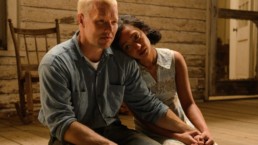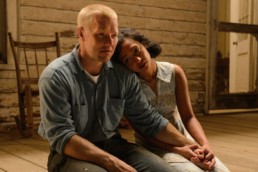‘Loving’ Review: The Quiet Hurt in the Price of Loving
'Loving,' in theaters today, is devoid of all types of fantastical conventions and cliches, standing as nearly a polar opposite and one of the year's most affecting love stories.
Hollywood love stories are stuffed with such overly-romanticized plots – boy-meets-girl introductions, flamboyant declarations of love, impassioned embraces (be it in the rain or otherwise) – that they also take on a layer of artificiality in which the story of two people in love is all but lost.
Loving, in theaters today, is devoid of all types of fantastical conventions and cliches, standing as nearly a polar opposite and one of the year’s most affecting love stories.
Based on a true story, Loving tells the story of Richard and Mildred Loving, a mixed-race couple living in the deep Virginian South in the late fifties whose union of marriage jails them and further threatens their civil liberties, setting up a seemingly uphill battle against them and the world. Except, here again, Loving doesn’t position itself to work in the conventions of Richard and Mildred Loving to actively fight against their enemies, being the local townspeople, state police department, or Supreme Court.
So, if it’s not a Hollywood romance, and it’s not a social justice movie, then what exactly is this movie? Writer and director Jeff Nichols crafts Loving to be a love story unlike most others– a movie as naturally paced as the rhythm of the crickets in the field. Simply put – Nichols tells a story of two people in love with each other, and how in that love, all other factors act as peripheral. As this reviewer notes, it’s as if even the movie is an unwarranted intrusion of their own relationship, speaking to their total humility.
What credits this movie to be so powerful? Well, Nichols’ work is of course, commendable, allowing the story to be told with center-composed photography and medium-framed shots and effective use of lighting and shadows. But the real magic in Loving, which comes as no surprise, lies in the performances of Joel Edgerton and Ruth Negga.
With his bleached hair and yellowed teeth, Joel, in a career-best performance, tenderly shapes the character of Richard to be if not the most articulate Southerner, then certainly one with the purest of hearts, whose puppy-dog innocence doesn’t consider that choosing to be with a woman of color is wrong for the times. His quiet but powerful depiction is beset by the winning performance from Ruth Negga as Mildred, who displays equal humility and captivates the screen with her enormous watery eyes and graceful performance. Those simple acts of looking at each other in the eyes and whispers of nighttime confessions are the heart of this movie.
There’s a recurring sequence in Loving that may sum up the film, and should be looked out for. Richard’s brick-laying work is returned to multiple times and may stand for his and Mildred’s relationship as relating to the world. In Virginia, Richard slops concrete onto bricks, laying bricks at a dizzying and reckless speed (perhaps Richard is initially ignorant towards the society where he lives). After moving to Washington D.C., Richard lays bricks slowly, more precisely, with the intense focus of using his leveling tool (perhaps Richard is now fully aware of how he must tread lightly and follow rules precisely so). And finally, when the resolution comes in the film’s final sequence… well, let’s just say that a self-made string aligns the bricks he lays, perhaps symbolizing how Richard and Mildred ultimately created the rules for how they were to live their life.
‘Loving’ is rated PG-13 for thematic elements. Opens in theaters this Friday.
Ryan Rojas
Ryan is the editorial manager of Cinemacy, which he co-runs with his older sister, Morgan. Ryan is a member of the Hollywood Critics Association. Ryan's favorite films include 2001: A Space Odyssey, The Social Network, and The Master.


